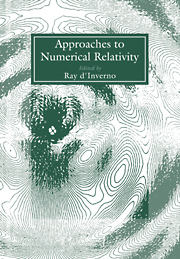Book contents
- Frontmatter
- Contents
- Contributors
- Introduction
- Preface
- PART A THEORETICAL APPROACHES
- PART B PRACTICAL APPROACHES
- Numerical asymptotics
- Instabilities in rapidly rotating polytropes
- Gravitational radiation from coalescing binary neutron stars
- “Critical” behaviour in massless scalar field collapse
- Godunov-type methods applied to general relativistic stellar collapse
- Astrophysical sources of gravitational waves and neutrinos
- Gravitational radiation from 3D gravitational stellar core collapse
- A vacuum fully relativistic 3D numerical code
- Solution of elliptic equations in numerical relativity using multiquadrics
- Self-gravitating thin discs around rotating black holes
- An ADI scheme for a black hole problem
- Time-symmetric ADI and causal reconnection
- The numerical study of topological defects
- Computations of bubble growth during the cosmological quark-hadron transition
- Initial data of axisymmetric gravitational waves with a cosmological constant
- PANEL DISCUSSION
Computations of bubble growth during the cosmological quark-hadron transition
Published online by Cambridge University Press: 15 December 2009
- Frontmatter
- Contents
- Contributors
- Introduction
- Preface
- PART A THEORETICAL APPROACHES
- PART B PRACTICAL APPROACHES
- Numerical asymptotics
- Instabilities in rapidly rotating polytropes
- Gravitational radiation from coalescing binary neutron stars
- “Critical” behaviour in massless scalar field collapse
- Godunov-type methods applied to general relativistic stellar collapse
- Astrophysical sources of gravitational waves and neutrinos
- Gravitational radiation from 3D gravitational stellar core collapse
- A vacuum fully relativistic 3D numerical code
- Solution of elliptic equations in numerical relativity using multiquadrics
- Self-gravitating thin discs around rotating black holes
- An ADI scheme for a black hole problem
- Time-symmetric ADI and causal reconnection
- The numerical study of topological defects
- Computations of bubble growth during the cosmological quark-hadron transition
- Initial data of axisymmetric gravitational waves with a cosmological constant
- PANEL DISCUSSION
Summary
Abstract. An outline is given of a scheme being used for making computations of the growth of single hadronic bubbles during the cosmological quark-hadron transition. The code uses a standard Lagrangian finite-difference scheme for flow within the bulk of each phase together with continuous tracking of the phase interface across the grid by means of a characteristic method with iterative solution of junction conditions.
INTRODUCTION
In view of the subject of this meeting, our emphasis here will be on the computational aspects of our study of the cosmological quark-hadron transition (Miller & Pantano 1989, 1990; Pantano 1989). However, as a preliminary, it is good to recall some fundamental points of the physics lying behind the calculations.
According to present ideas, hadrons are composed of quarks which move freely within a hadron but are strongly constrained from leaving. A phenomenological description of this is provided by the MIT bag model (Chodos et al 1974) where the region occupied by the quarks is associated with a false vacuum state characterized by a uniform vacuum energy density B and an associated negative pressure – B. If normal hadronic matter were compressed to high enough density, the individual hadrons would overlap and the quarks would become free to move within the entire interior region, giving rise to a quark-gluon plasma. Heavy-ion collision experiments at CERN and Brookhaven are aiming to create transient plasma in the course of collisions and to look for signatures of its decay.
Information
- Type
- Chapter
- Information
- Approaches to Numerical Relativity , pp. 335 - 344Publisher: Cambridge University PressPrint publication year: 1992
